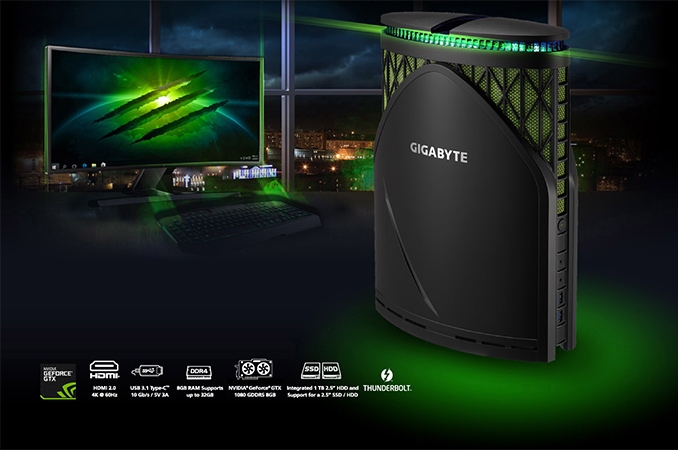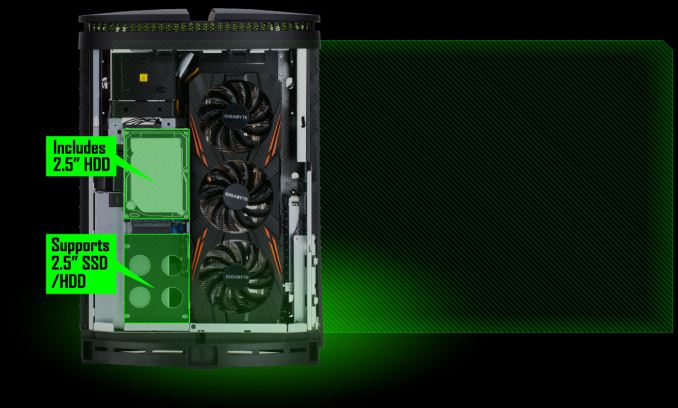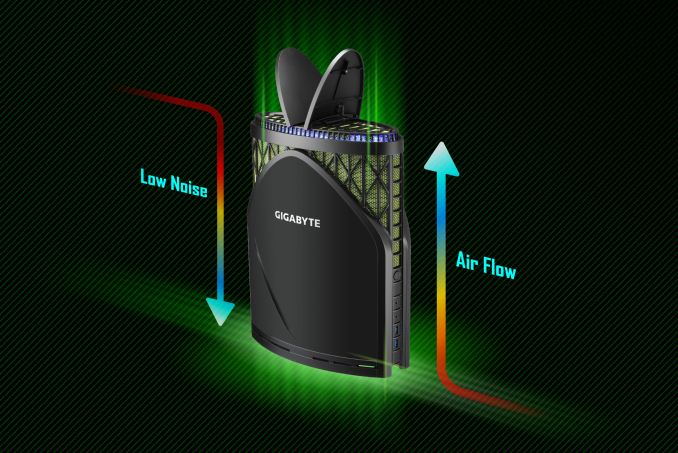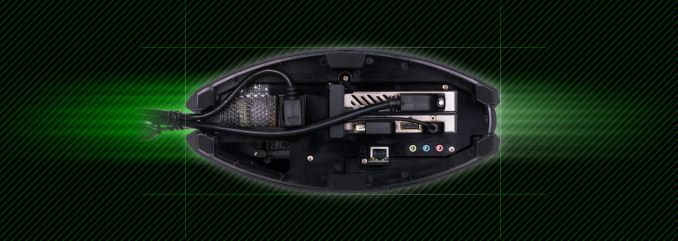GIGABYTE's New Console: The 'Gaming GT' PC Launched with Core i7-K, GTX1080, TB3
by Anton Shilov on December 30, 2016 4:00 PM EST
GIGABYTE has quietly announced its new small form-factor computer designed for performance-minded gamers. The new SFF PC not only packs high-performance components, such as the latest-generation CPU and GPU, but it uses desktop-class components and could be upgradeable.
High-performance PCs in small form-factor are not rare nowadays: various PC makers use mobile CPUs and GPUs to build such systems. Such computers demonstrate high-performance out-of-the-box, but their upgrade strategy is tricky because it is not easy to get MXM GPUs or mobile CPUs in retail. When developing the GIGABYTE Gaming GT desktop (GB-GZ1DTi7-1080-OK-GW and technically this PC belongs to the Brix family), engineers from GIGABYTE wanted to create a product that could use widely available processors and graphics cards and thus potentially offer an upgrade path to the owners.
The GIGABYTE Gaming GT desktop is not really a miniature system: it measures 276×384×128 mm and is approximately 10 liters in volume, which makes it just larger than Sony’s first-generation PlayStation 3. The PC is based on a custom motherboard (210×205 mm) that is a bit larger than Mini-ITX, but is still smaller when compared to microATX or FlexATX. The system uses a dual-chamber design (CPU, DRAM, SSD are located on one side of the PC, graphics card and other 2.5” storage devices are on the other side), but the chambers are not isolated completely because they use the same airflows generated by two system fans (we do not know how large they are, but theoretically they may be of 90 mm in diameter). It is noteworthy that the PC has an automated exhaust system that opens up exhaust flippers at the top of the computer when it needs to cool down the components.
The chassis can accommodate any double wide graphics card with a maximum size of 280 mm in length and 41 mm in depth, but nothing too custom with regards heatpipes and backplates because the space is constrained. GIGABYTE will ship the Gaming GT desktop with its own GeForce GTX 1080 G1 Gaming 8 GB card, but they say the key thing is that it can be updated later. Since the card faces downwards, it has to use custom cables (bundled) to connect to displays. Audio and Ethernet cables also have to be angled, but at least it is not a big problem to find such cables in retail. On the bright side of things, the Gaming GT desktop uses a 400 W FlexATX PSU, which could be upgraded if needed.
| GIGABYTE Gaming GT Spefications | |
| GB-GZ1DTi7-1080-OK-GW | |
| CPU | Intel Core i7-6700K Quad Core with HT 4.0 GHz/4.2 GHz 91 W |
| PCH | Intel Z170 |
| Graphics | GIGABYTE GeForce GTX 1080 G1 Gaming 8 GB GDDR5X 2560 stream processors 160 texture units 64 raster operations pipelines |
| Memory | 32 GB of DDR4 (2×16 GB DDR4) |
| Storage | 240 GB SSD (PCIe/SATA?) 1 TB 2.5" HDD (7200 RPM) 1×2.5" bay for HDD/SSD (SATA) |
| Wi-Fi | Intel 1×1 Dual Band Wireless-AC 3165NGW 802.11ac + BT |
| Ethernet | Rivet Networks Killer E2400 Gigabit LAN |
| Display Outputs | 1 × DVI-D DL 1 × HDMI 2.0b 1 × HDMI 1.4 (uses iGPU) 3 × DisplayPort 1.4 |
| Audio | 5.1-channel audio Realtek ALC1150 codec TI Burr Brown OPA2134 operational amplifier |
| USB | 5 × USB 3.0 Type-A (5 Gbps) 1 × USB 3.1 Type-A (10 Gbps) 1 × Thunderbolt 3/USB 3.1 Type-C (10 Gbps) |
| Other I/O | - |
| Dimensions | 276 mm × 384 mm × 128 mm 10.86 × 15.11 × 5 inches |
| PSU | FlexATX 400 W |
| OS | Windows 10 Home |
The custom motherboard of the GIGABYTE Gaming GT PC is based on the Intel Z170 PCH and thus supports all LGA1151 processors, including the upcoming Kaby Lake chips. The manufacturer will ship the system with the Intel Core i7-6700K CPU (so, overclocking seems to be possible, but keep in mind temperatures and noise), but eventually the chip might be switched to something more powerful.

The GIGABYTE Gaming GT PC will come with 32 GB of dual-channel DDR4 memory, a 240 GB SSD (M.2 form-factor, but no word on performance), a 1 TB HDD with a 7200 RPM spindle speed and an additional 2.5” bay for an extra drive. For those, who are not satisfied with an M.2 SSD and two 2.5” HDDs/SSDs, GIGABYTE even installed one Thunderbolt 3 port to connect external high-performance storage devices or special-purpose hardware. When it comes to other I/O, then the Gaming GT desktop offers a dual-band 1×1 802.11ac + BT 4.2 wireless module, Gigabit Ethernet (Killer E2400), five USB 3.0 Type-A ports, one USB 3.1 Type-A (10 Gbps) port, 5.1-channel audio (the Realtek ALC1150 with the TI Burr Brown OPA2134 amplifier) and so on.
Finally, to give its Gaming GT system a distinctive look, GIGABYTE installed a series of RGB LEDs on top of it. The LEDs can work in different modes and can be controlled using the company’s Ambient LED application.
Pricing and availability dates for the GIGABYTE Gaming GT SFF PCs were not available at press time. Keep in mind that actual configuration of the PC will differ based on the regions, which means that their prices will vary as well. Chances are we'll see it at CES next week.
Related Reading:
- Zotac ZBOX MAGNUS EN1080 SFF PC Review: A Premium Gaming Powerhouse
- GIGABYTE Updates The Aero 14 Thin Gaming Laptop: Now with a GeForce GTX 1060 GPU
- Calyos NSG Cube: Passively Cooled SFF PC with Intel Core and GeForce GTX 1060
- ZOTAC ZBOX MAGNUS ERX480: SFF PC with Intel Core i5, AMD Radeon RX480, USB-C
Source: GIGABYTE


















42 Comments
View All Comments
Murloc - Sunday, January 1, 2017 - link
it's also cool and gives you spaceship or race car with flaps feelings. So hardcore.Laststop311 - Wednesday, January 4, 2017 - link
I suspect it has more to do with the noise. 2x 90mm fans responsible for circulating all the heat from 271 watts of TDP means those fans are going to be spinning fast. They keep the top covered as much as possible because the noise is going to be terrible with them open.ciparis - Monday, January 2, 2017 - link
I can't imagine that the "automated" part is anything more than "opens when the air pressure below it pushes it open" -- i.e., when the fans are running fast enough to generate the air pressure (which would not need to be much at all).nagi603 - Sunday, January 1, 2017 - link
I have a 1080 with a 4770K running and a lot of other stuff (multiple SSDs, capture card, etc). Depends on the quality of the PSU. I have an old Seasonic X-400 Gold, and it does not have any issue. Also didn't have an issue with a 290X.Laststop311 - Wednesday, January 4, 2017 - link
yea seasonic PSU's are known to be able to run comfortably over their stated max watts. That seasonic can most likely run 500-550 watts without breaking a sweat. And it's still not a smart idea to stress the PSU like that even if it works. And overclocking is a no go. PSU's are most efficient between 40-50%. So if your system uses 300 watts total while in use best to match it up with a 550 watt psu so you can hit the psu's highest efficiency rating which can be like 94% efficient at the halfway mark reducing heat made by the psu thereby allowing the psu fan to rotate very slow making no noise.Murloc - Sunday, January 1, 2017 - link
hobby computer builders oversize their PSUs by A LOT because they don't want any doubt, but if you assemble a computer in series you're only going to put what is truly necessary in it.Laststop311 - Wednesday, January 4, 2017 - link
400 watt is cutting it close the tdp is 91 watts for the cpu but it draws more like 120 watts of actual power when maxed out at 100%. When the GPU is maxed out at 100% it uses a bit over 200 watts of actual power. That leaves 80 watts for the motherboard including the ram, PCH and fans as well as the storage devices. That leaves no breathing room for overclocking and you may not be able to use really high end 250-300 watt tdp gpu's. If flex atx is about the same size as the sfx psu's you could easily replace it with a 650 watt sfx psu and give yourself enough room to overclock and use beefier gpu's.The problem with this PC is there will most definitely be a price premium for the compactness and engineering that went into making this. Also due to the size the noise level is going to be higher than a standard build in a nice sound absorbing fractal define r5. Upgrading it will be more difficult and time consuming. Is it worth it to pay extra money for a louder, hotter running and harder to upgrade pc just so you can have a smaller pc? I would say N + O.
Laststop311 - Wednesday, January 4, 2017 - link
Now if they can offer this for a price that is within 100-200 dollars of building a standard mid ATX tower. It could be interesting then but i doubt it. I expect at least a 500-750 dollar premium vs building the same thing in a mid ATX case and you get better overall performance in speed noise and heat with a mid ATX build, that combined with a 500+ savings makes me think not many will want this.wolrah - Friday, December 30, 2016 - link
Argh why the stupid Killer NIC? Give me Intel or nothing. Killer is nothing but a marketing department run amok.DigitalFreak - Friday, December 30, 2016 - link
Agreed, but you have to remember these systems aren't marketed to most people who read this site. To them, Killer sounds cooler than Intel.